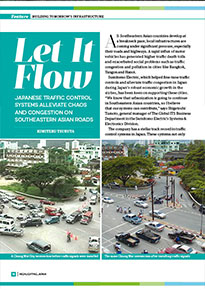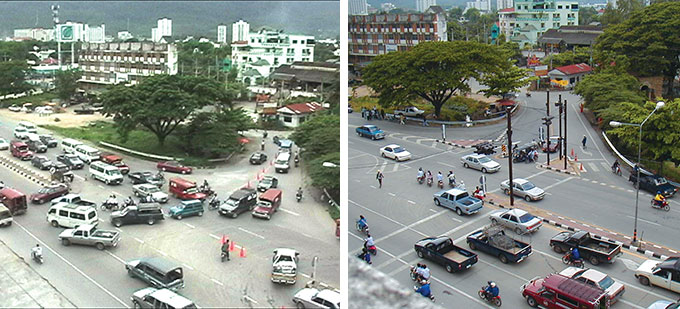Home > Highlighting JAPAN >Highlighting Japan December 2014>Building Tomorrow's Infrastructure
Highlighting JAPAN

Building Tomorrow's Infrastructure
Let It Flow
Japanese Traffic Control Systems Alleviate Chaos
and Congestion on Southeastern Asian Roads

As Southeastern Asian countries develop at a breakneck pace, local infrastructures are coming under significant pressure, especially their roads and highways. A rapid influx of motor vehicles has generated higher traffic death tolls and exacerbated social problems such as traffic congestion and pollution in cities like Bangkok, Yangon and Hanoi.
Sumitomo Electric, which helped fine-tune traffic controls and alleviate traffic congestion in Japan during Japan’s robust economic growth in the sixties, has been keen on supporting these cities. “We know that urbanization is going to continue in Southeastern Asian countries, so I believe that our systems can contribute,” says Shigetoshi Tamoto, general manager of The Global ITS Business Department in the Sumitomo Electric's Systems & Electronics Division.
The company has a stellar track record in traffic control systems in Japan. These systems not only eased traffic congestion, they also contributed to cutting Japan’s traffic fatalities from a record high of 16,000 in 1970 to about half that by the end of the decade. The company achieved this by working with the National Police Agency and Tokyo Metropolitan Police Department to set up one of the first computerized traffic signal systems that displayed preprogrammed signal patterns based on traffic conditions.
The company has continued to innovate in the field, taking advantage of recent developments in information technology to amass gargantuan amounts of traffic data through sensors installed on the roadside and repeatedly analyzing it. Rather than just adjusting the traffic signals to current traffic conditions, Sumitomo Electric’s newest system actually predicts those conditions and selects the optimal signal control.
Improving traffic systems in overseas cities isn’t simply about exporting the technology. “We know that just setting up a system that we have in Japan doesn’t work over there,” Tamoto says. He adds that local officials and residents have to understand how the system works and be on the same page.
Through the Japan International Cooperation Agency (JICA), Sumitomo Electric partnered with the city of Chiang Mai in northern Thailand in 2001 and participated in an experiment to improve the city's intersections. To ease the gridlock, the company designed better intersections and traffic lanes as well as installing traffic signal controllers. Based on this experience, from 2003 to 2004, it supplied Phuket with another traffic signal system, which has significantly eased the traffic congestion problem there.
In 2006, the company partnered with the Royal Thai Police to tackle traffic congestion and accidents, which have been Bangkok’s biggest issues. By installing 152 image sensors at 45 intersections and setting up a network that can relay data from the streets to the traffic control center, traffic management officers can now virtually “see” the traffic.
The project in Bangkok hasn’t been a completely smooth ride, however, because the implementation of citywide traffic control systems that utilizes the data from the sensors hadn’t been deployed yet. The company is now making headway as it cooperates with local universities and industries to emphasize the importance of traffic control systems, and at same time to analyze the data to identify, understand and better cope with traffic events.
Although there is a growing need for smart traffic control systems across China and emerging Southeastern Asian countries, Sumitomo Electric understands that conditions in each country are different, and each has its own requirements.
“While the technology is rapidly evolving, we’d like to customize and make sure that it’s a system in line with local traffic conditions,” says Tamoto. Sumitomo Electric, which has made significant contributions to the improvement of Japan’s traffic conditions, is currently expanding its presence globally and will reinforce its efforts to establish a safe and secure society free from traffic accidents and congestion.
*ITS: Intelligent Transport Systems
© 2009 Cabinet Office, Government of Japan






